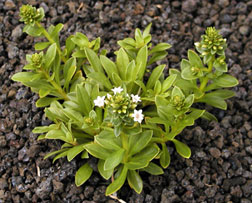
|
In The Garden
Rick Barboza
|
Ground cover blooms brightly and sows its own seeds
Coastal Lysimachia
Latin: Lysimachia mauritiana
Description: A low, crawling herbaceous ground cover with light green, succulent leaves and white flower clusters. The leaves emerge radially from the center, giving it a nice shape, while the flower clusters protrude above the rest of the plant, allowing them to be shown off. Once pollinated, the flowers develop into small, light brown seed capsules, each containing many tiny, dark brown seeds.
 HUI KU MAOLI OLA
Lysimachia makes an excellent groundcover. Use it to highlight large landscape stones in a garden, or as bedding.
|
|
Distribution: Seldom seen in the wild, this is the only native Lysimachia found today that is indigenous and occurs at low elevations. All other native Lysimachia are considered endemic and occur in higher, wetter elevations. This plant is naturally found on coastal cliffs or rocky shorelines on the islands of Niihau, Kauai, Molokai, Maui and Hawaii -- pretty much everywhere but Oahu. This plant is indigenous, therefore it is native to other places, including other Pacific islands, Japan, Korea, India, Taiwan and China.
Landscape use and care: Lysimachia looks great planted around large landscape stones or when used as a bedding plant. It doesn't spread far, at about 1 square foot, so space accordingly. Few pests are known to bother this plant, but if some sort of infestation does occur, proper application of store-bought pesticides will not harm it.
This plant is naturally short-lived, so don't be concerned if it slowly dies after one to two years -- that's natural. Ideally, the plant would have set a bunch of seeds, and your next round of plants should germinate shortly after that. Other than that it is still an attractive plant.
For a limited time it is available at Home Depot stores in town and Pearl City for about $6.
Cultural uses: Flower clusters are used in head leis.
Additional information: Although it's not found on Oahu today, it's hard to say that this plant was never found here. It occurs naturally where many migratory birds forage, so it could easily be transported from island to island. Who knows, maybe someday this plant will occur naturally here again in the future.
Rick Barboza co-owns Hui Ku Maoli Ola, a native Hawaiian plant nursery, with Matt Schirman. Contact him at 295-7777 or e-mail
Rick.CK.Barboza@gmail.com

